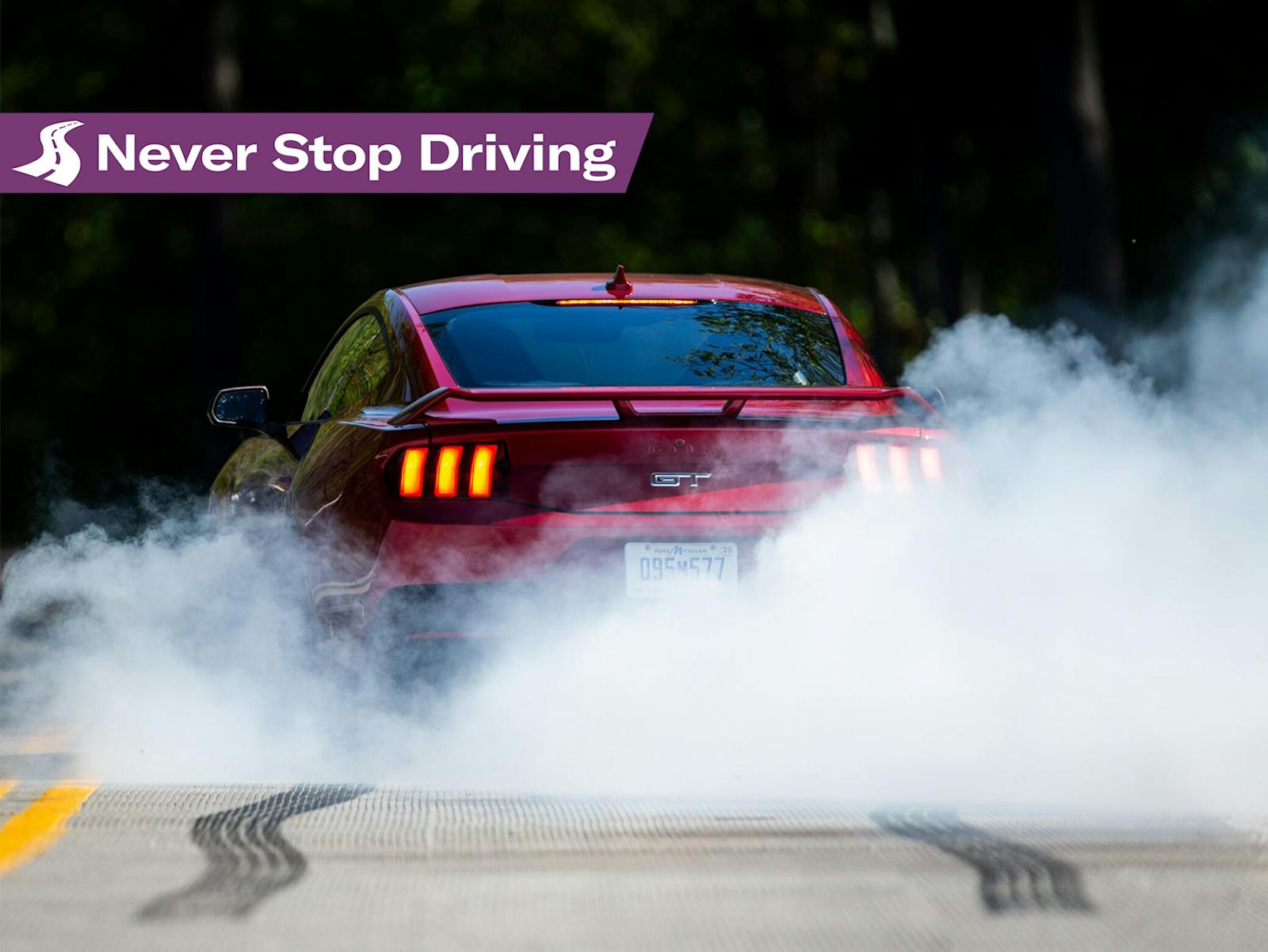Never Stop Driving #27: Is the Mercedes Hypercar pointless?
The long-delayed Mercedes hypercar, the AMG ONE, set the record for the fastest production car around Germany’s Nürburgring racetrack: six minutes and 35 seconds. The sports car will cost nearly three million dollars and uses a derivative of a Formula 1 engine.
I find myself yawning at this achievement and I’m not sure why. I certainly appreciate the engineering effort behind the car and the audacity of the project. Back in 2017, when Mercedes announced its intentions for the car, the company boasted that AMG-ONE would be “the most extraordinary, contemporary, road-legal racing car.”
I’m also a huge fan of lap-time-based performance tests, having started two U.S.-based ones in my career. I organized the one that survives, Car and Driver’s Lightning Lap, in 2006 after Warren Mosler, the “mad scientist” behind the Consulier, suggested the U.S. needed a version of Germany’s Nürburgring test. I agreed and picked Virginia International Raceway’s (VIR) grand course because of the wide variety of turns but also for its 4.1-mile length.
The VIR record in 2006—three minutes and seven tenths of a second (3:00.7)—was set by a Ford GT. Last year, the raciest version of the Honda Civic, the Type R, set the same time. In roughly 15 years, Honda engineers figured out how to make a Civic perform like a $100,000 mid-engine sports car. Wow. Also, Honda just updated its little terror.

So, the most expensive Mercedes ever built set the record. Got it. The 275 buyers will love and covet it. The car joins a pile of seven-figure hypercars, from the Aston Martin Valkyrie to the Bugatti Chiron to the McLaren Senna to the Ferrari Daytona SP3 to the whatever is newest and next. I’d be grateful to own any of them, but the sheer number of models is starting to feel like a bit much. I’m not alone in this thinking.
By the way, I do find one of these hypercars, the Gordon Murray T.50, very intriguing. Built by the same man who was behind the McLaren F1 road car three decades ago, the T50 is billed as the last great analog sports car. It’s got a high-revving V-12 and a manual transmission and is already sold out.
Meanwhile, back in the real world, a four-mile stretch of Tennessee highway was equipped with some 300 high-definition cameras to study traffic and congestion patterns. Vanderbilt University will use the new highway and conduct a test featuring 100 vehicles equipped with driver-assist systems to see if perhaps automated cruise controls can smooth out traffic patterns.
Waymo announced that now anyone can hire a ride with one of its autonomous taxis. Previously, riders had to preregister. Waymo will also soon join Cruise by offering driverless rides in San Francisco.
If you like to wrench on cars, Rob Siegel explains how to avoid the usual nightmare of repairing cars for friends. One day, Siegel might be fixing the latest BMW M car, the M4 CSL, which Henry Catchpole reviews here. We wrote a love letter to the Tri-Five Chevy and the Barn Find Hunter Tom Cotter took us on a tour of fantastically wacky Lane Motor Museum.
This newsletter will take a break next week for the holiday. I hope you and your family have a wonderful Thanksgiving!
Hear from me every Friday by subscribing to this newsletter.
Check out the Hagerty Media homepage so you don’t miss a single story, or better yet, bookmark it.


What I wonder is which car was able to stop the quickest after they passed the finish line. I bet the AMG stops a lot quicker than the Honda!
Appreciate this quick read article.
Like the subject and the references.
Agree – fast is fast – but this is merely throwing mountains of money at the laws of physics. I’m sure Merc could have made an even faster $5MM car….or $7MM car….or $10MM car…what’s the point after a while?
Let’s just cut to the chase, strap a license plate on a 919, and call it good.
What’s more interesting to me is to look at Nurburgring lap times through an Index of Performance lens.
Let’s say, based on MSRP, how much per second does it cost the owner of that AMG ONE to achieve the advertised Nurburgring lap time?
Answer: About $7,600/sec
To put that into perspective:
Mercedes AMG GT Black: $797/sec
Porsche 911 GT3 (992.1): $384/sec
Corvette ZO6 w/ZO7 (C7): $212
So yeah the AMG ONE may be the fastest, but it’s certainly not the most clever car out there.
There’s a law of diminishing returns with speed and at some point a tenth costs millions. Just look at F1.
Completely pointless. Indeed there is nothing more boring than raw acceleration and speed, especially on our overcrowded roads. Even in Germany it’s pointless, the Autobahn is wall to wall with cars these days too. Finesse is so much more satisfying, a clutch/shift/clutch done just right. Negotiating a curve just right. Trying to see just how smoothly you can stop and start. Heck I never had more fun than driving my X/19 on a country road. Slow as paint drying but whoo boy was the handling sweet.
On a side note, can someone tell us how Jay Leno is doing?
I enjoy watching the arms race of hyper cars from an engineering perspective, but none of them make the cut for my 10 car dream garage. The T.33 is the only thing even remotely appealing to me to drive on the open road.
In my experience automated cruise control is less smooth than regular cruise, because everytime someone faster passes and cuts in front it makes my car slow down abruptly and then speed back up! Especially irritating on I 70 across the Great American Desert – Kansas and Eastern Colorado.
Mercedes makes one of the most amazing cars ever and you poo poo? Your analysis is entirely wrong.
Definitely has some flaws. Tell me your side
While I agree with the, yawn, 275 built, already sold out, who cares take normally when a car like this is made… The aforementioned Aston Martin Valkyrie, Bugatti Chiron, Divo, McLaren Senna, Ferrari Daytona SP3, fall into that category for me at the end of the day, yes. Beautiful machines in all of their own rights but, besides lapping them around Forza and seeing them, if I’m lucky, at a cars & coffee one day yea, who cares.
The AMG One is a different beast though. Mercedes didn’t just build it to build it like those other guys. They went in with a purpose. The lofty goal of making a road-going car with a functional, day-to-day usable, actual Formula 1 engine. And it took forevvvver to design, build, troubleshoot, build some more, to finally get here because of the sheer task of taking an engine designed to be used solely at the limit for a limited amount of time and making it road-friendly. And that feat, while enormous, is still capped, to just under 32,000 miles before a complete factory rebuild Is needed. But they did it damnit! And that’s why this car and that task, the jubilation the entire team at Mercedes must feel about it, that’s what makes this car un-yawnable, and separate from other brands’ halo cars.
Look this is a showcase car much like the McLaren F1. At the time the McLaren arrived it was the same lap times and tech but with time we learned to understand it and just what the car means. Same with the F40.
Mercedes has done several cars like this but never really sold them. I see this as a Benz send off of their ICE tech in a car.
Benz has always had the tech and the performance but they just never had the image of a Ferrari or McLaren. But that is the German way. Function before form. I am sure this car will be mechanically a one of the best super cars but the image is just not the same.
Pointless no. Miles Stone Yes.
Good article about the Hypercar not being so exclusive anymore, not that I can afford one. I did read the article on the Gordon Murray’s T.50 which is intriguing. The the last line was that it should be completed by August 2020 – soooo, was it completed?
Pointless? No. It serves many purposes as do all manufacturers “limited” production test beds. They make a statement about a brands relevancy, as well as providing feedback on new technologies which could conceivably find their way into their production vehicles among other goals. Only the manufacturer can truly make a case as to whether the development expenditure is worth the investment.
I thought is was just me no longer being impressed by hyper priced hyper cars. I was seriously impressed with the C8 Corvette as it breached performance thresholds at reasonable value. That is a much more meaningful achievement. Great article, thanks for not making me feel like such a curmugeon.
Larry….I agree about the tendency to yawn at the ever expanding list super cars for super rich folks. As you say back in the real world, we have greater need to continue improving safety and efficiency. As a comment to the Vanderbilt study, I think we should develop a global standard by which ALL vehicles can talk to each other and arbitrate rights of way, thereby eliminating entirely collisions. It’d take many years to get the majority of vehicles on roadways up to this standard but eventually the days of human error caused collisions would be very low. Additionally traffic flow would be greatly improved as “traffic control devices” could be eliminated at some point say 50 years down the road.
Bob Beisang
It’s a sad day when folks start to consider cars which push the boundaries of style and speed as irrelevant.
You Said … The VIR record in 2006—three minutes and seven tenths of a second (3:00.7)—was set by a Ford GT.
What did the AMG do it in ? Else this is ‘pointless’ !
They haven’t run the AMG at VIR. It’s an endless struggle to borrow cars like that for testing.
The development of these supercars is a great real world examples of technology that “trickles down” to the masses. Direct injection, electric turbos, carbon fiber, 300 hp 4-bangers. They are costly to get, expensive to maintain, and if you’re XL in size, uncomfortable, ask me how I know. But they do serve a purpose.
I’m more interested in the transition of pure sales of vehicles by manufactures to the sales plus subscriptions. I own a TV that has 5 different streaming subscriptions, my daughter’s Yukon has a technology subscription to stay connected. This is the next cash grab for manufacturers as they create this new process that will become the norm going forward. I don’t like it. I bet the AMG doesn’t come with a required subscription.
Stepping off soapbox.
For a future article, how about tire pressure monitors (TPMs). Why are they not standardized across the industry like rubber valve stems, let alone changing at the same manufacturer on the same model? I just had to spend $200 for new TPMs for the winter tire and wheel setup on my wife’s 2022 Compass. It wasn’t until I mounted them up that I found they didn’t work on the ’22 even though they did work on the previous ’20 Compass as well as the ’21 Cherokee. Frustrating and seems like racket. Maybe that is something the SAE could put on its agenda.
SO What?
a good “food for thought” article, and i agree.
note: it’s more fun to drive a slow car fast that a fast car slow.
thanks again.